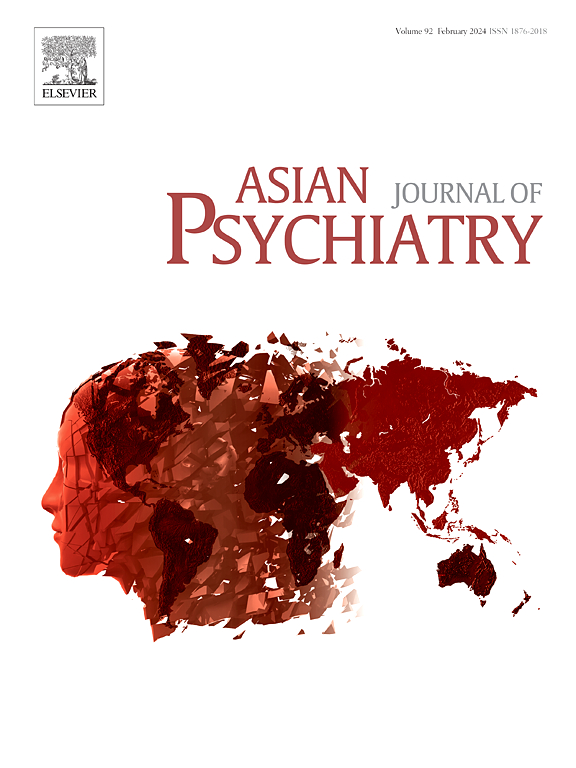中国大学生自杀危机量表-2 (SCI-2)的因素结构与效度检验
IF 4.5
4区 医学
Q1 PSYCHIATRY
引用次数: 0
摘要
中国大学生的自杀念头和行为(STB)状况令人担忧。自杀危机量表-2 (SCI-2)是一种评估自杀危机综合征(STB的一个迫在眉睫的警告信号)的工具,可以有效地筛查和预防STB。然而,在中国大学生中,与STB相关的SCI-2及其关键项目的心理测量特性尚未得到探讨。方法进行两项研究,共纳入11,620名中国大学生。在研究1 (N = 1480)中,我们使用验证性因子分析(CFA)和其他方法调查了SCI-2的心理测量特性。在研究2中,我们用机器学习方法探索了与STB相关的关键SCI-2项目。在样本1 (N = 5296)中,我们根据研究1的CFA结果选择特征,构建了四个基于树的模型。在样本2 (N = 4844)中,我们对模型进行外部测试。Shapley加性解释(SHAP)值用于模型解释。结果SCI-2的单因素模型和五因素模型在中国大学生中均可接受,且SCI-2与STB等标准具有良好的内部一致性和收敛效度。同时,SCI-2的困陷和社交退缩类核心症状对STB的SHAP值较高。结论SCI-2量表适用于评价我国大学生的临危自杀风险。困住和社交退缩的症状需要额外关注。本文章由计算机程序翻译,如有差异,请以英文原文为准。
The revised Suicide Crisis Inventory-2 (SCI-2) in Chinese college students: Examining factor structure and validity
Background
The situation of suicidal thoughts and behaviors (STB) among Chinese college students is concerning. The Suicide Crisis Inventory-2 (SCI-2), an assessment tool for suicide crisis syndrome (an imminent warning sign of STB), can effectively contribute to screening and preventing STB. However, the psychometric properties of the SCI-2 and its key items associated with STB have not been explored in Chinese college students.
Methods
We conducted two studies with a total of 11,620 Chinese college students included. In study 1 (N = 1480), we investigated the psychometric properties of the SCI-2 using confirmatory factor analyses (CFA) and other methods. In Study 2, we explored key SCI-2 items associated with STB with machine-learning approaches. In sample 1 (N = 5296), we selected features based on the CFA results in study 1 and built four tree-based models. In sample 2 (N = 4844), we externally tested the models. Shapley Additive exPlanations (SHAP) values were used for model interpretation.
Results
The one-factor and five-factor models of the SCI-2 are both acceptable among Chinese college students, and SCI-2 showed good internal consistency as well as convergent validity with STB and other criteria. Meanwhile, the core symptoms within the entrapment and social withdrawal clusters of the SCI-2 showed higher SHAP values to STB.
Conclusion
The SCI-2 is suitable for assessing the imminent suicide risk among Chinese college students. Symptoms of entrapment and social withdrawal need additional attention.
求助全文
通过发布文献求助,成功后即可免费获取论文全文。
去求助
来源期刊

Asian journal of psychiatry
Medicine-Psychiatry and Mental Health
CiteScore
12.70
自引率
5.30%
发文量
297
审稿时长
35 days
期刊介绍:
The Asian Journal of Psychiatry serves as a comprehensive resource for psychiatrists, mental health clinicians, neurologists, physicians, mental health students, and policymakers. Its goal is to facilitate the exchange of research findings and clinical practices between Asia and the global community. The journal focuses on psychiatric research relevant to Asia, covering preclinical, clinical, service system, and policy development topics. It also highlights the socio-cultural diversity of the region in relation to mental health.
 求助内容:
求助内容: 应助结果提醒方式:
应助结果提醒方式:


